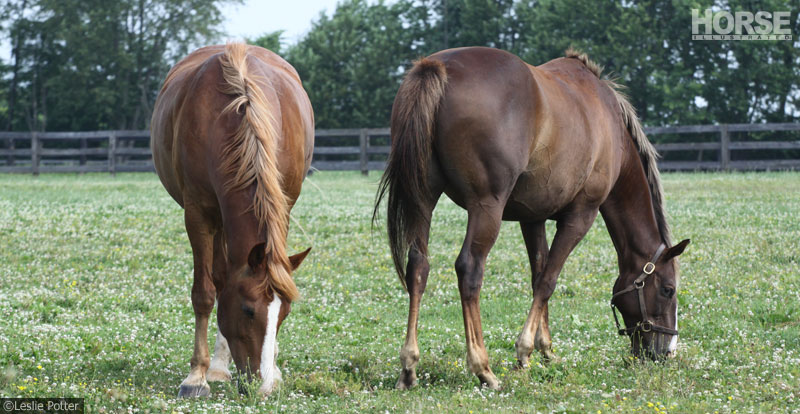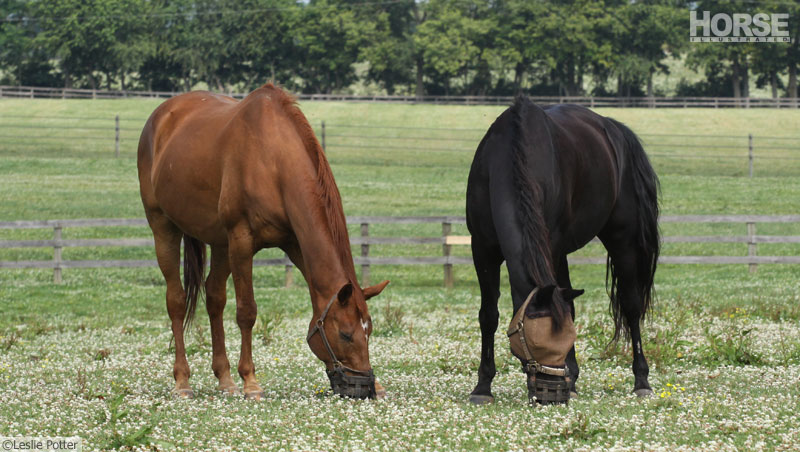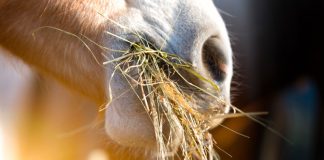
Picture this: a lush, green field with a horse peacefully grazing. This image is almost every horse owner’s ideal vision of their horse at his happiest. But danger can lurk for some horses if you look a little deeper.
High-Risk Horses
Horses most at risk for laminitis are those with equine metabolic syndrome (EMS) and Cushing’s disease (also called pituitary pars intermedia dysfunction, or PPID).
Horses and ponies with EMS often have telltale symptoms, including a tendency toward obesity, insulin resistance and recurrent laminitis. Abnormal fat deposits along the crest of the neck, tailhead and above the eyes are typical, even when the horse is at a normal weight. The condition most often occurs in ponies and other breeds that evolved under harsh conditions and tend to be easy keepers.
Horses with PPID may have symptoms similar to EMS, such as patchy fat deposits and insulin resistance, but PPID usually begins to appear in older horses (over age 15). They may also start to lose topline muscling and develop a thick haircoat that sheds out later than normal, or eventually not at all.
If you suspect your horse has either of these conditions, schedule a vet visit for blood tests that will help confirm a diagnosis. If your horse has a metabolic disease, consider it a huge warning flag that he is at high risk for pasture-associated laminitis.
The Carbohydrate Connection to Founder in Horses
Laminitis can be caused by grazing on pasture that is too high in non-structural carbohydrates (NSCs). These include fructan, sugar and starch. Structural carbohydrates are the fibrous parts of the cell wall that give the plant rigidity; these are digested differently from NSCs.
You may have heard that fructan is the singular evil element in grass that causes horses to founder. However, more recent research has shown that pasture-induced laminitis cannot be attributed solely to fructan. There is no fructan in warm-season grasses, yet horses can still founder on them. Since the same environmental conditions that create high fructan concentrations also increase sugar and starch levels, it’s best to just limit all NSCs.
Conditions that Spell Trouble
In order to prevent laminitis in high-risk horses, you’ll need to start thinking about weather and grass-growing conditions. When the sun is shining brightly but other conditions limit the growth of the plant, NSC concentration in pasture plants will increase.
Here is a list of the danger signs to look for:
Temperature
“If it’s below 40 degrees Fahrenheit, the enzymes that help the plant grow don’t function anymore,” says Kathryn Watts, an internationally respected consultant and researcher specializing in pasture grass and horses and ponies prone to laminitis. She is based in Colorado and maintains a website at safergrass.org. “However, photosynthesis [which creates sugar] happens as long as the sun is shining, provided that the plant is not frozen solid.”
Concentrations of NSCs can double or even triple if these conditions (sunny and below 40 degrees) continue for several weeks. Since this commonly happens during spring and fall in many parts of the country, these seasons are often associated with grass founder in horses.
TIP: A useful tool that you can find at any hardware store is a min-max thermometer. Put it on the back porch and check it every morning. If it’s been below 40 degrees that night, start paying careful attention to any high-risk horses. After a few nights below 40, any horse that’s had laminitis in the past or has the body type that says “founder waiting to happen” should probably be removed from pasture entirely and fed hay that’s tested for low sugar content (see “Testing Sugar Content,” below).
Lack of Fertilizer
“Another thing that can limit plant growth is lack of fertilizer—usually nitrogen,” says Watts. “The plant might have enough sugar, but if it doesn’t have enough nitrogen to put that sugar to work and grow, the sugar starts piling up. I use the analogy of an assembly line: If the plant does not have all of the elements it needs to grow, the line shuts down and the other raw materials pile up.”
Since a lack of nitrogen can limit grass growth, it’s important to have the right fertilization schedule for your region. “Approach your extension agent or fertilizer dealer and tell them you’re looking for a moderate fertility level, not maximum production,” Watts advises.
Drought
Drought is another form of stress that will result in sugars piling up within the plant. “For example, in Texas, founder season happens when it’s very sunny and very hot,” says Watts. Drought may also cause fructan in cool-season grasses to turn to sugar, increasing chances of metabolically driven laminitis.
Mature Grass
When managing pastures, it’s important to mow or top the grass before seed heads appear. “Sugars and starch are very concentrated in the developing seed heads,” says Watts. “Many horses selectively graze them off; it’s like horse candy.”
Weeds
Most pastures are filled with weeds that horses are more than happy to consume.
“Some of the weeds in your pasture have the potential to contain more sugar than the grass,” says Watts. “The ones that I have tested personally that are really high in NSCs include dandelion, plantain and thistle.”
You can treat pastures with an herbicide to kill broadleaf weeds such as dandelions, which are particularly palatable to horses. Often this is enough to decrease the incidence of founder.
A thick, healthy stand of grass is the best defense against invasion of weeds and clover. While proper fertilization can decrease sugar concentration per mouthful of grass, there may now be more sugar per acre. When grass is more plentiful in previously overgrazed pastures, you may need to start limiting intake with a muzzle or decreased time at pasture.
It’s important to note that weeds may grow around dry lots where horses and ponies are housed to keep them off pasture. If those weeds are within reach of desperate flapping lips of horses, the risk of founder is still there. You may very well save your horse from foundering just by running a weed-whacker around the dry lot.
“Safe” Grazing
Regardless of what season the calendar says it is, keep an eye out for dangerous grazing conditions all year long.
“The worst places for laminitis are those where the grass stays green all winter long, like in Great Britain and the Pacific Northwest,” says Watts. “Their grass doesn’t ever really die. When the temperature is below 40 degrees, any green grass creates a problem for high-risk horses, regardless of what month it is.
“Here in Colorado, by December the grass is completely brown,” she continues. “If the weather has been dry, the grass can still be high in sugars.” Sugars may be leached out eventually by rain and melting snow, except in the case of grasses with a waxy coating, such as fescue. Fescue is commonly found in Kentucky and the Southern states, so keep in mind that it may be holding on to sugar longer if you are planning to put your horse on it in the winter or during a summer drought.
“People assume that dead grass has no nutritional value if it’s brown,” adds Watts. “But sugar is not green. The chlorophyll and protein may be gone, but the sugar isn’t necessarily gone. Don’t assume that brown grass is safe.”
Testing Sugar Content
If you’re unsure about your grass or hay’s sugar content, the best thing to do is get it tested. “Grab a few handfuls of brown grass and send it to Equi-Analytical Laboratories [the equine division of Dairy One Cooperative Inc.] and have it analyzed,” says Watts. This is only accurate if the grass is completely dead. (If the grass is green, you would have to flash freeze it and send it overnight on dry ice, which is very expensive.) If it’s dead, you can treat it like hay.
Average grass hay is around 12 percent non-structural carbohydrates on a dry matter basis but can range up to 30 percent. For high-risk horses, grass or hay should be less than 11 percent. This varies by individual horse and how much exercise he’s getting. As you test more hay and compare how your horse does on each batch, you will learn what he can handle without gaining weight or getting sore feet. There is no “one size fits all” recipe.
If your high-risk horse has been pulled off pasture, it’s important to test your hay for sugar content. “Any kind of hay can be high or low in sugar,” says Watts. “It’s not about species; it’s about growing conditions.”
For a list of other National Forage Testing Association certified labs, visit www.foragetesting.org.
Managing the High-Risk Horse
If you have a high-risk horse with a cresty neck, one of the best things to keep an eye on is his neck. “When the sugars get high in the grass, you can palpate his neck and feel a difference,” says Watts. “I call it ‘the Neckometer.’ When you put him in the dry lot, within a couple of days you should feel his neck getting softer. If you do something wrong, his neck will get hard very quickly.”

If the weather is conducive to making high-sugar grass, horses with more mild risk factors may still be able to stay on pasture with a grazing muzzle on. “But if you put the grazing muzzle on and his neck is still getting bigger, then it’s time to put him in the dry lot and leave him there,” advises Watts. However, she emphasizes that the only way you can really assess your horse’s risk level is to get his insulin levels tested.
Early Signs of Laminitis
Another tool Watts recommends to carefully monitor high-risk horses is a daily brisk trot on firm footing. Since the metabolic form of laminitis comes on very slowly, it’s possible to look for these subtle signs and get ahead of the problem.
“If you have a horse that normally has a nice, big trot and suddenly he just shuffles along stiff-legged or refuses to trot at all, that’s the horse that you bring back to your dry lot,” says Watts. “Feel his feet to see if there’s excess heat or an obvious pulse. These horses will often respond to being withdrawn from pasture very quickly.”
Keep the horse off of pasture until weather conditions have changed completely in a way that will lower the concentration of sugar in the grass. For any case of acute laminitis, contact your vet immediately.
Since metabolic laminitis is a relatively new area of research, make sure your vet is up to date on the condition and knows how to treat it.
“Endocrinology is a veterinary specialty,” says Watts. “The same goes for farriers. The farrier you loved when your horse was healthy may not have the skills to help him once he’s foundered.”
Exercise is Key
Many of the horses that struggle with grass founder are not exercised at all, or only very lightly.
“Except for a few rare cases of very hard-to-control insulin resistance, if you exercise the horse hard enough (to a sweat) three times a week, you can fudge a lot more on the diet,” says Watts. “It’s about balancing the amount of exercise with the amount of NSCs in the diet.”
Horses that are prone to insulin resistance should not carry excess weight. Watts recommends horses be kept fit, even with a slight hint of ribs showing. But the horse should also carry good overall muscle tone from an active fitness program—whether it’s riding, driving or longeing.
If you have a high-risk metabolic horse and you want to maximize his grazing time, you’ll need to be prepared to carefully evaluate him and the weather conditions every day. At the first sign of foot soreness or the crest thickening/hardening, move him to a dry lot and feed him low-sugar hay, or soak his hay for a couple of hours in plenty of fresh water to remove excess sugars. When your horse and the grass conditions improve, he can go back out again. However, it may not be until the season is over. Be prepared for a time-consuming challenge.
Further Reading
◆ Treatment and Recovery of Founder in Horses
◆ Feed to Prevent Founder
◆ An Overview of Laminitis
This article about grass founder in horses originally appeared in the April 2013 issue of Horse Illustrated. Click here to subscribe!






good info
Great advice and great timing. The grass is growing!
I will hopefully have to start worrying about this, but as of now, we do not even have any bare spots in our pastures and fields. Snow is melting next to the buildings. But more snow is coming on Friday, tomorrow.
Thank you SO Much for your article! I just had the farrier out yesterday and unfortunately my horse has foundered. I have a difficult situation because I don’t live in the save property and don’t get to exercise him daily or do a off/on daily turnout. This article provides a great understanding and typos for founder.